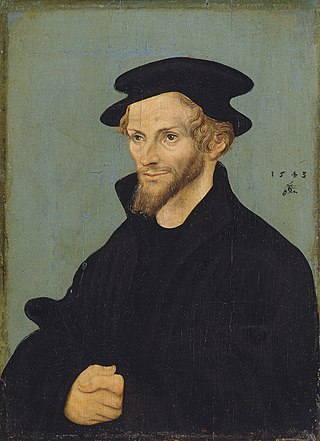
Philip Melanchthon was a German Lutheran reformer, collaborator with Martin Luther, the first systematic theologian of the Protestant Reformation, an intellectual leader of the Lutheran Reformation, and influential designer of educational systems.
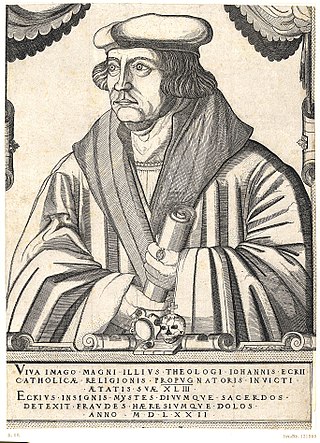
Johann Maier von Eck, often anglicized as John Eck, was a German Catholic theologian, scholastic, prelate, and a pioneer of the counter-reformation who was among Martin Luther's most important interlocutors and theological opponents.
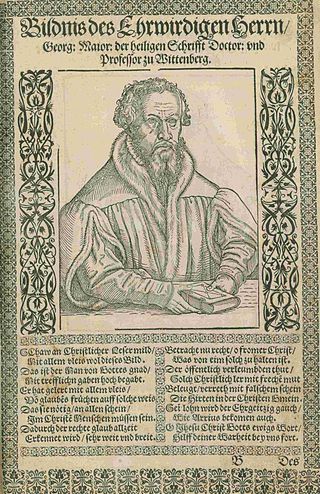
Georg Major was a Lutheran theologian of the Protestant Reformation.

Patrick Hamilton was a Scottish churchman and an early Protestant Reformer in Scotland. He travelled to Europe, where he met several of the leading reformed thinkers, before returning to Scotland to preach. He was tried as a heretic by Archbishop James Beaton, found guilty and handed over to secular authorities to be burnt at the stake in St Andrews as Scotland's first martyr of the Reformation.
Crypto-Calvinism is a pejorative term describing a segment of those members of the Lutheran Church in Germany who were accused of secretly subscribing to Calvinist doctrine of the Eucharist in the decades immediately after the death of Martin Luther in 1546. It denotes what was seen as a hidden Calvinist belief, i.e., the doctrines of John Calvin, by members of the Lutheran Church. The term crypto-Calvinist in Lutheranism was preceded by terms Zwinglian and Sacramentarian. Also, Jansenism has been accused of crypto-Calvinism by Roman Catholics.

The Book of Concord (1580) or Concordia is the historic doctrinal standard of the Lutheran Church, consisting of ten credal documents recognized as authoritative in Lutheranism since the 16th century. They are also known as the symbolical books of the Evangelical Lutheran Church.

The diets of Augsburg were the meetings of the Imperial Diet of the Holy Roman Empire held in the German city of Augsburg. Both an Imperial City and the residence of the Augsburg prince-bishops, the town had hosted the Estates in many such sessions since the 10th century. In 1282, the diet of Augsburg assigned the control of Austria to the House of Habsburg. In the 16th century, twelve of thirty-five imperial diets were held in Augsburg, a result of the close financial relationship between the Augsburg-based banking families such as the Fugger and the reigning Habsburg emperors, particularly Maximilian I and his grandson Charles V. Nevertheless, the meetings of 1518, 1530, 1547/48 and 1555, during the Reformation and the ensuing religious war between the Catholic emperor and the Protestant Schmalkaldic League, are especially noteworthy. With the Peace of Augsburg, the cuius regio, eius religio principle let each prince decide the religion of his subjects and inhabitants who could not conform could leave.
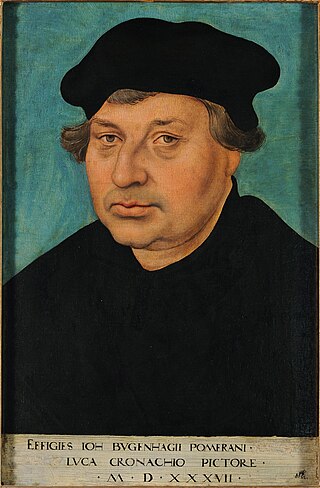
Johannes Bugenhagen, also called Doctor Pomeranus by Martin Luther, was a German theologian and Lutheran priest who introduced the Protestant Reformation in the Duchy of Pomerania and Denmark in the 16th century. Among his major accomplishments was organization of Lutheran churches in Northern Germany and Scandinavia. He has also been called the "Second Apostle of the North".
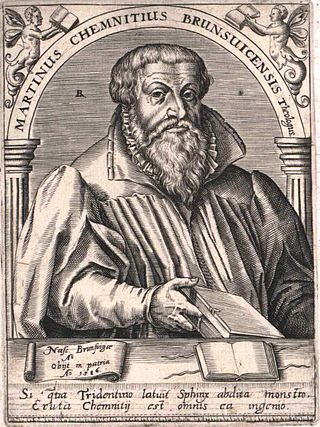
Martin Chemnitz was an eminent second-generation German, Evangelical Lutheran, Christian theologian, and a Protestant reformer, churchman, and confessor. In the Evangelical Lutheran tradition he is known as Alter Martinus, the "Second Martin": Si Martinus non fuisset, Martinus vix stetisset goes a common saying concerning him. He is listed and remembered in the Calendar of Saints and Commemorations in the Liturgical Church Year as a pastor and confessor by both the Evangelical Lutheran Church in America and Lutheran Church–Missouri Synod.
The Treatise on the Power and Primacy of the Pope (1537), The Tractate for short, is the seventh Lutheran credal document of the Book of Concord. Philip Melanchthon, its author, completed it on 17 February 1537 during the assembly of princes and theologians in Smalcald.
Lutheranism as a religious movement originated in the early 16th century Holy Roman Empire as an attempt to reform the Roman Catholic Church. The movement originated with the call for a public debate regarding several issues within the Catholic Church by Martin Luther, then a professor of Bible at the young University of Wittenberg. Lutheranism soon became a wider religious and political movement within the Holy Roman Empire owing to support from key electors and the widespread adoption of the printing press. This movement soon spread throughout northern Europe and became the driving force behind the wider Protestant Reformation. Today, Lutheranism has spread from Europe to all six populated continents.
Lutheran orthodoxy was an era in the history of Lutheranism, which began in 1580 from the writing of the Book of Concord and ended at the Age of Enlightenment. Lutheran orthodoxy was paralleled by similar eras in Calvinism and tridentine Roman Catholicism after the Counter-Reformation.

Martin Luther was a German priest, theologian, author, hymnwriter, professor, and Augustinian friar. He was the seminal figure of the Protestant Reformation, and his theological beliefs form the basis of Lutheranism.
Loci Theologici was a term applied by Melanchthon to Protestant systems of dogmatics and retained by many as late as the seventeenth century. It is also a way of ordering the strength of different sources used in Catholic theology usually attributed to Melchor Cano and still in use today.
Robert Kolb is professor emeritus of Systematic Theology at Concordia Seminary, St. Louis, Missouri, and a world-renowned authority on Martin Luther and the history of the Reformation.
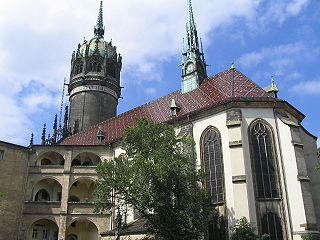
All Saints' Church, commonly referred to as Schlosskirche to distinguish it from the Stadtkirche of St. Mary's, sometimes known as the Reformation Memorial Church, is a Lutheran church in Wittenberg, Saxony-Anhalt, Germany. It is the site where, according to Philip Melanchthon, the Ninety-five Theses were posted by Martin Luther in 1517, launching the beginning of the Protestant Reformation.
Gnesio-Lutherans is a modern name for a theological party in the Lutheran churches, in opposition to the Philippists after the death of Martin Luther and before the Formula of Concord. In their own day they were called Flacians by their opponents and simply Lutherans by themselves. Later Flacian became to mean an adherent of Matthias Flacius' view of original sin, rejected by the Formula of Concord. In a broader meaning, the term Gnesio-Lutheran is associated mostly with the defence of the doctrine of Real Presence.
The Augsburg Confession, also known as the Augustan Confession or the Augustana from its Latin name, Confessio Augustana, is the primary confession of faith of the Lutheran Church and one of the most important documents of the Reformation. The Augsburg Confession was written in both German and Latin and was presented by a number of German rulers and free-cities at the Diet of Augsburg on 25 June 1530.
Viktorin (Victorinus) Strigel was a Philippist Lutheran theologian and Protestant reformer.

Johannes Aepinus (1499–1553) was a German Lutheran theologian, the first Superintendent of Hamburg from 1532 to 1553, presiding as spiritual leader over the Lutheran state church of Hamburg.











